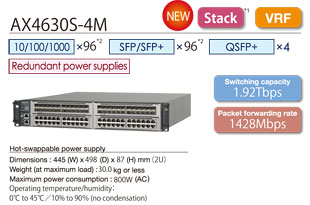
Layer 3 chassis-type switch (crossover switch)AX4600S Series
The AX4600S is a crossover switch designed with a totally new concept: combining a chassis-type switch (featuring flexibility and scalability) and a box-type switch (featuring compactness and cost-efficiency).
The AX4600S, like a chassis-type switch, supports various types of interface cards that are replaceable but employs a compact engine, the same type of engine used in a box-type switch, thereby achieving high cost efficiency, high flexibility and high performance.
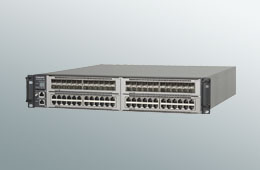
- A core switch making it possible to upgrade bandwidth as required
- The replaceable interface cards of the AX4600S enable flexible use of bandwidth (mixture of 1G /10G) commensurate with a network size.
- VRS (Virtual Redundant System) achieves simple system redundancy of a core switch.
- Network Partition enables configuration of a highly-secured virtual network.
- Suitable for use as an aggregation switch that aggregates ToR switches of data centers
- The AX4600S, with its high 10G port density, accelerates data processing and optimizes usage of server resource.
- Simple device redundancy using VRS ensures the reliability of an aggregation switch under concentrated traffic.
- Possible to configure an L2 flat wide-area virtual network that enables resource relocation among data centers
- VXLAN (Virtual eXtensible Local Area Network) makes it possible to configure L2 VPNs over the existing L3 networks.
- Other benefits brought by VXLAN: resource optimization, efficient capital investment, infrastructure for business continuity plans (BCPs), disaster recovery (DR), etc.
Network Configuration Example
Large Size Campus Network
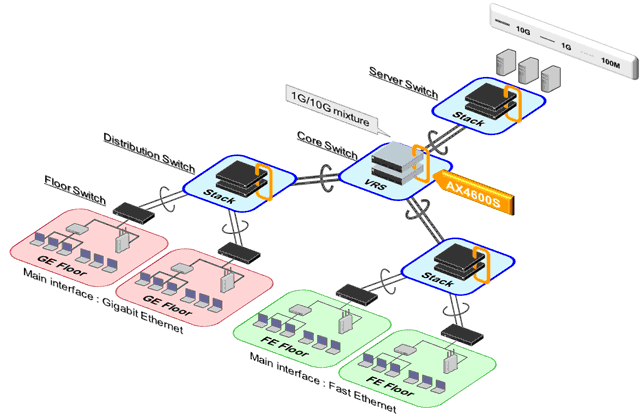
- Core switch
- 2U-sized compact body with high scalability and high flexibility (modular-type switch that eases device replacement and system enhancement)
- Suitable for use in an environment in which 1G and 10G are mixed (interface cards are replaceable)
- High reliability (VRS, full link aggregation)
- Virtualization ensuring security for individual departments (network partition)
- Field-proven layer 3 functionality (OSPF/BGP, IPv6, multicast, etc.)
Small/medium Size Campus Network
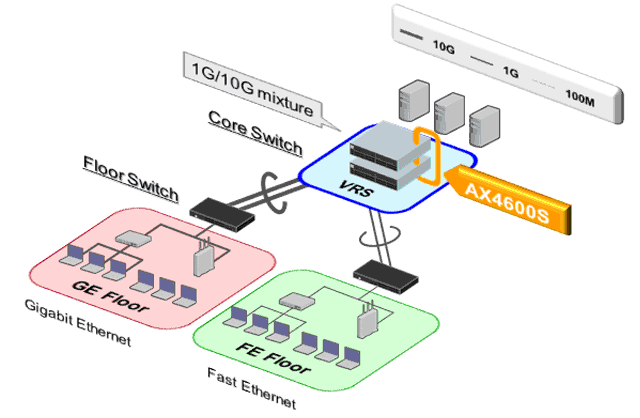
- Core switch
- 2U-sized compact body with high scalability and high flexibility (modular-type switch that eases device replacement and system enhancement)
- Suitable for use in an environment in which 1G and 10G are mixed (interface cards are replaceable)
- High reliability (VRS, full link aggregation)
- Virtualization ensuring security for individual departments (network partition)
- Field-proven layer 3 functionality (OSPF/BGP, IPv6, multicast, etc.)
Data Center
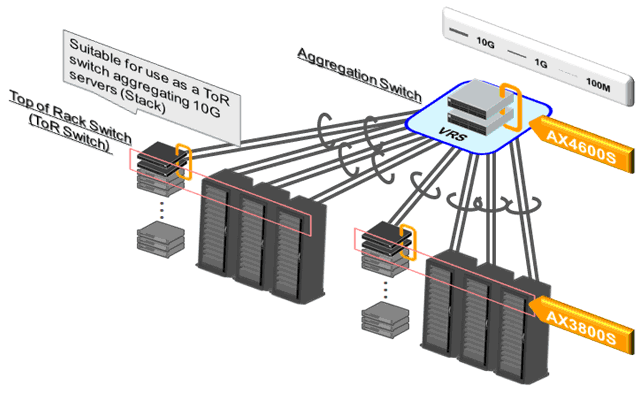
- Aggregation switch
- 2U-sized compact body with high scalability and high flexibility (modular-type switch that eases device replacement and system enhancement)
- High performance (Max. switching capacity: 1.92 Tbps)
- Possible to aggregate many ToR switches by 10G connection
- High reliability (VRS, full link aggregation)

IPv6 Ready Logo
Phase2(Core)
(Logo-ID-:02-C-001232)
High Cost Efficiency and High Scalability
Crossover switch combining chassis/box
- Features of a box-type switch (compact body and cost efficiency) and a chassis-type switch (flexibility and scalability)
- 2U height with four network interface card (NIF) slots
- Mixture of 1G/10G
High port density
- Max. 1.92 Tbps switching capacity
- Support of various Ethernet interfaces
- 1G or 10G : 96 ports
- #
- The number of usable 1G/10G ports on a NIF is reduced by four each time you use one 40G backside port.
- 1G or 10G : 96 ports
Large Entry Capacity
Enhanced ARP entry capacity
- Larger capacity than that of a traditional box-type switch
- ARP table entries increased to 45K
Fault Tolerant Network
Non-stop network
- STP-free redundancy with full link aggregation prevents trouble associated with system complexity and enhances network stability.
Virtual Redundant System (VRS)
- Two switches can be logically integrated into a single unit (simple redundancy and easy operation management).
- Dual Active doubles the bandwidth of a system.
- Four 40 Gpbs ports for VRS links are provided on the back of the switch.
Protocol Accelerator (PA)
- Hardware called Protocol Accelerator enables hardware-assisted switchover.
VXLAN (Virtualization)
Network virtualization for the age of cloud
- VXLAN (Virtual eXtensible Local Area Network), an RFC standard, is supported.
- L2 extension (L2-VPN) among multiple locations, using the existing networks and carrier services, is possible.
- Multi-tenant network across multiple locations/data centers can be configured at lower cost than the networks using the conventional techniques (VPLS/MPLS).
Network Partition (Virtualization)
Simple low-cost network virtualization
- Combination of VRF (Virtual Routing and Forwarding) and VLAN (Virtual LAN) logically splits a network.
- Secure, highly reliable virtual networks (partitions) can be configured at low cost.
Virtual Router (VRF)
- Makes it possible to configure a virtual network by having multiple independent routing tables in a single unit.
Flexible networking
- Possible to consolidate networks based on wide area Ethernet by distributing resources to multiple sites on a LAN.
- Possible to use the same IP address for each partition (enables flexible configuration without being nervous about address duplication).
- Use of triple authentication enables secure login to partitions.
High Reliability and High Availability
ALAXALA Ring
- ALAXALA proprietary L2 redundancy protocol enables fast failover with 1 sec. (minimum time).
- Multi-ring topologies are also supported (increases flexibility in network configuration).
Loop detection
- Detects miscabling to avoid loop faults.
Storm control
- Prevents total system failure that may be caused by storm.
QoS
- Provides fine-tuning QoS: priority control to give higher priorities to important packets and delay-sensitive packets (e.g., voice packets), bandwidth control to allocate a set amount of bandwidth to switch ports, and so on
Hot-swappable power supply
- The built-in redundant power supply makes it possible to replace a power supply unit without interrupting services.
Stable High-Functionality Routing
Reliable field-proven routing functionality
- The AX4630S employs high-reliability routing software equivalent to that of a carrier-grade router.
IPv6
High-speed IPv4/IPv6 routing
- Hardware-based fast routing for IPv4/IPv6
- Various IPv6 protocols: Static, RIPng, OSPFv3, and BGP4+
High Speed and High Performance
Low-cost 10G network
- Possible to use direct attach cables (not require expensive optical transceivers).
Power-Saving and Eco-Friendly Design
Power-saving design
- The AX4630S employs power-saving architecture, circuits and modules.
Airflow suited to data centers
- The AX4630S provides front-to-back airflow for data centers' cooling systems.
Simple Operation Management and Maintenance
Unified CLI
- Supports command line interfaces common to all the models of the AX series (consolidated operation management and maintenance).
Command-free maintenance
- SD Card Script enables automatic log saving / firmware update.
AX4630SDescriptions for the marks
- *1
- : VRS (Virtual Redundant System) is used.
- *2
- : The number of usable 1G/10G ports on a NIF is reduced by four each time you use one 40G backside port.
Click image for larger view
AX4630S
| Model | AX4630S-4M | ||
|---|---|---|---|
| Performance | Max. Switching capacity (Tbit/s) | 1.92 | |
| Max. Packet forwarding rate (Mpacket/s) | 1428 | ||
| Port count | 40GBASE-CR4/SR4/LR4 (QSFP+) | 4 #1 | |
| 10GBASE-CU/SR/LR/ER (SFP+) | 96 #2 | ||
| 1000BASE-SX/LX/BX/LH (SFP) | 96 #2 | ||
| 1000BASE-T (SFP) | 96 #2 | ||
| 10BASE-T/100BASE-TX/ 1000BASE-T |
96 #2 | ||
| Routing protocol | IPv4 | Unicast | Static, RIP, RIP2, OSPF, BGP4, Policy-based routing |
| Muliticast | PIM-SM, PIM-SSM, IGMPv2/v3 | ||
| IPv6 | Unicast | Static, RIPng, OSPFv3, BGP4+ | |
| Muliticast | PIM-SM, PIM-SSM, MLDv1/v2 | ||
| Layer 2 features | Max. MAC entry capacity | 96K | |
| VLAN | Port VLAN, Tag-VLAN (IEEE802.1Q), Protocol VLAN, MAC VLAN, Tag translation | ||
| Spanning Tree Protocol (STP) | STP (IEEE802.1D), RSTP (IEEE802.1w), PVST+, MSTP (IEEE802.1s), BPDU filter, Root guard, Loop guard | ||
| IGMP / MLD | IGMPv1/v2/v3 snooping, MLDv1/v2 snooping | ||
| Ring Protocol | Autonomous Extensible Ring Protocol | ||
| Other | L2 loop detection, Storm control, IEEE802.3ah/UDLD, Ether OAM | ||
| Advanced features | Authentication | Triple authentication (IEEE802.1X, Web-based authentication, MAC authentication) | |
| Security | Filtering (L2/IPv4/IPv6/L4), inter-port relay blocking, DHCP snooping | ||
| QoS | Flow detection (L2/IPv4/IPv6/L4), Bandwidth monitoring (UPC (policer)), Marking (DSCP/user priority), Priority control (flow-based, user priority mapping), Discard control, Shaping (port bandwidth control, scheduling (PQ, PQ+RR, PQ+WFQ, PQ+WRR, PQ+WERR)), Diff-serv | ||
| High reliability | Virtual Redundant System (VRS), Load balancing (IPv4/IPv6), VRRP (IPv4/IPv6), Static polling (IPv4/IPv6), VRRP polling (IPv4/IPv6), Link aggregation (IEEE802.3ad), GSRP, Uplink redundancy, Graceful Restart #3 | ||
| Virtualization (Network Partition) | VRF (Virtual Routing and Forwarding), Inter-VRF relay | ||
| Other | IPv4 DHCP relay agent, IPv4 DHCP server, IPv6 DHCP server (Prefix delegation) / relay agent, L2-VPN (VLAN tunneling), VXLAN functionality | ||
| Operation | Network management | SNMPv1/v2c/v3, MIB-II, IPv6 MIB, sFlow, LLDP, Port mirroring, RMON, OADP, CDP | |
| Maintenance | CLI, Command-free maintenance (SD card script), RADIUS, SSH #4, syslog, ping, traceroute, telnet, ftp, tftp, NTP, TACACS+ | ||
| Power saving | Power consumption information indication | ||
| Static power saving | Powering off ports | ||
| Dynamic power saving | Powering off ports (scheduling) | ||
| Airflow | Front-to-back | ||
| Redundancy | Built-in power supply (AC), FAN unit | ||
| Equipment conditions |
Input voltage | AC100 to 120V / 200 to 240V | |
| Max. input current (A) | 8.0@AC100V / 4.0@AC200V | ||
| Max. power consumption (W) | 800 | ||
| Max. heat output (kJ/h) | 2880 | ||
| Dimensions: W x D x H (mm) [height: U] | 445 x 498 x 87 (2U) | ||
| Weight (Kg) (including power supply) | 30.0 or less | ||
| Environmental conditions | Operating temperature | 0°C to 45°C | |
| Non-operating temperature | -10°C to 50°C | ||
| Storage / transportation temperature | -25°C to 65°C | ||
| Operating humidity | 10% to 90% (non-condensing) | ||
| Non-operating humidity | 8% to 90% (non-condensing) | ||
| Storage / transportation humidity | 5% to 90% (non-condensing) | ||
| Floating dust | Floating dust of about 10 microns or smaller : 0.15mg/m3 | ||
- #1
- There are four 40G ports on the back of the device.
- #2
- The number of usable ports on a NIF is reduced by four each time you use one 40G backside port.
- #3
- Supports Helper function (OSPF / OSPFv3) and Receive Router function (BGP4 / BGP4+).
- #4
- SSH function is subject to export control regulations, and may be excluded when exported.
- [Note] Functions supported by L3S advanced software: OSPF / OSPFv3 / BGP4 / BGP4+ / VRF / Policy-based routing / VXLAN


